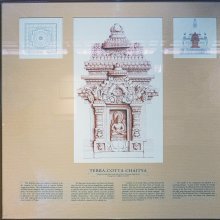Benares: 3 definitions
Introduction:
Benares means something in Buddhism, Pali, Hinduism, Sanskrit, the history of ancient India. If you want to know the exact meaning, history, etymology or English translation of this term then check out the descriptions on this page. Add your comment or reference to a book if you want to contribute to this summary article.
Images (photo gallery)
In Hinduism
Jyotisha (astronomy and astrology)
Source: Wisdom Library: Brihat Samhita by VarahamihiraBenares refers to an ancient kingdom identified with Kāśī, according to the Bṛhatsaṃhitā (chapter 5), an encyclopedic Sanskrit work written by Varāhamihira mainly focusing on the science of ancient Indian astronomy astronomy (Jyotiṣa).—Accordingly, “If there should be both lunar and solar eclipses in one month, princes will suffer both from dissensions among their own army and from wars. [...] If the solar or lunar eclipse should fall in the lunar month of Kārttika, persons who live by fire, the Magadhas, the eastern princes, the Kosalas, the Kalmāṣas, the Śūrasenas and the people of Benares [i.e., Kāśī] will suffer miseries; the ruler of Kaliṅga with his ministers and servants and the Kṣatriyas will perish but there will be prosperity and plenty in the land”.

Jyotisha (ज्योतिष, jyotiṣa or jyotish) refers to ‘astronomy’ or “Vedic astrology” and represents the fifth of the six Vedangas (additional sciences to be studied along with the Vedas). Jyotisha concerns itself with the study and prediction of the movements of celestial bodies, in order to calculate the auspicious time for rituals and ceremonies.
In Buddhism
General definition (in Buddhism)
Source: Wisdom Library: BuddhismBenares refers to one of the places visited by Dharmapāla during his tour of North India. Anāgārika Dharmapāla (born 1864) was a Ceylonese Buddhist who travelled across India and beyond, spreading Buddhism. According to Bhikkhu Sangharakshita in his Biographical Sketc, “he travelled as a pilgrim, not caring at all for comforts, mixing with the sanyasins, ascetics, Hindu pilgrims, and with passengers of the third and intermediate classes, eating at times the poorest food, sleeping at times in places where the poor sleep and gaining an insight into the characteristics of the poor classes, who are suffering from intense ignorance, superstition and poverty”.
India history and geography
Source: Ancient Buddhist Texts: Geography of Early BuddhismBenares is another name for Bārāṇasī, the capital of Kāsī: one of the sixteen Mahājanapadas of the Majjhimadesa (Middle Country) of ancient India, as recorded in the Pāli Buddhist texts (detailing the geography of ancient India as it was known in to Early Buddhism).—It was at Benares that the Buddha gave his first discourse on the Dhammacakka or the wheel of Law. The Buddha met an Ājivika named Upaka on his way to Benares to preach the wheel of Law at Isipatana Migadāya. He reached Benares after crossing the Ganges at Prayāga direct from Verañjā. The Buddha spent a great part of his life at Benares. Here he delivered some of the most important discourses and converted many people. Bārāṇasī (mod. Benares) had other names as well, viz. Surundhana, Sudassana, Brahmavaddhana, Pupphavatī, Ramma and Molinī. The extent of the city is mentioned as 12 yojanas whereas Mithilā and Indapatta were each only seven leagues in extent.
Benares was a great centre of industry, trade, etc. There existed trade relations between Benares and Sāvatthī and between Benares and Taxila. The people of Benares used to go to Taxila. We read in the Susīma Jātaka that a certain youth of Benares Went to Taxila, two thousand leagues away from the former, to learn the ‘hatthi-sutta’. We know from the Bhojājāniya Jātaka (No. 23) that ‘all the kings round coveted the kingdom of Benares’.

The history of India traces the identification of countries, villages, towns and other regions of India, as well as mythology, zoology, royal dynasties, rulers, tribes, local festivities and traditions and regional languages. Ancient India enjoyed religious freedom and encourages the path of Dharma, a concept common to Buddhism, Hinduism, and Jainism.
See also (Relevant definitions)
Full-text (+921): Varanasi, Kashi, Kashika, Rudravasa, Mahashmashana, Manikarnika, Tirtharaji, Tapahsthali, Matsyodari, Bhelupura, Varanaseya, Kashinatha, Kukkutamandapa, Avimukta, Kashistotra, Madhyameshvara, Bhurishreshthika, Kashimahatmya, Baranasi, Shivarajadhani.
Relevant text
Search found 125 books and stories containing Benares; (plurals include: Benareses). You can also click to the full overview containing English textual excerpts. Below are direct links for the most relevant articles:
Vinaya Pitaka (3): Khandhaka (by I. B. Horner)
The story of the merchant’s son < [8. Robes (Cīvara)]
On rejection of human flesh < [6. Medicine (Bhesajja)]
On permission for woollen garments, etc. < [8. Robes (Cīvara)]
The Mahavastu (great story) (by J. J. Jones)
Chapter X - The Śarakṣepa-jātaka (story of the arrow that was shot far) < [Volume II]
Chapter XVI - Earlier history of Padumāvatī (former birth) < [Volume III]
Chapter XL - The Jātaka of Yaśoda < [Volume III]
A History of Indian Philosophy Volume 4 (by Surendranath Dasgupta)
Part 8 - Life of Vallabha (1481-1533) < [Chapter XXXI - The Philosophy of Vallabha]
Part 2 - The Life of Caitanya < [Chapter XXXII - Caitanya and his Followers]
Part 5 - Some Companions of Caitanya < [Chapter XXXII - Caitanya and his Followers]
The Jataka tales [English], Volume 1-6 (by Robert Chalmers)
Jataka 336: Brahāchatta-jātaka < [Volume 3]
Jataka 127: Kalaṇḍuka-jātaka < [Book I - Ekanipāta]
Jataka 282: Seyya-jātaka < [Book III - Tika-Nipāta]
Varahi Tantra (English Study) (by Roberta Pamio)
From Jaipur to Benares < [November 1947]
A French Savant on Dr. Bhagavan Das < [July-August 1933]
Mahatma Gandhi On Tour < [January-February, 1930]
Related products

